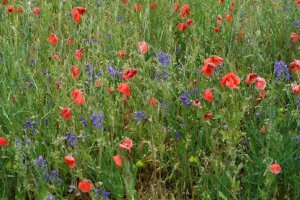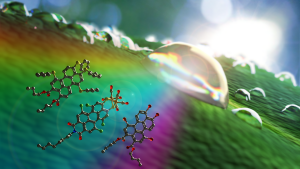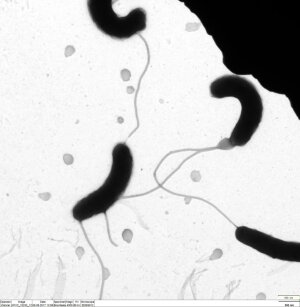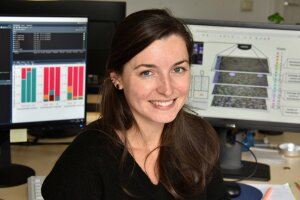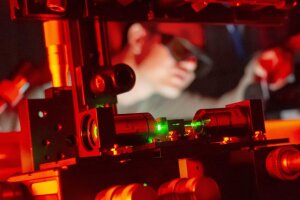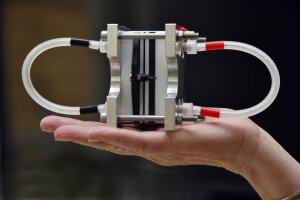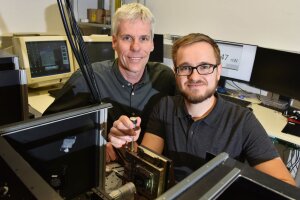Ticker
.
Image: Jens Meyer (University of Jena)Molecular teamwork
Everyone knows we can achieve more as a team. Chemists at the University of Jena have applied this everyday knowledge to a compound containing two gallium atoms, which work together in such a way that they can break the particularly strong bond between fluorine and carbon in other substances (DOI: 10.1021/ jacs.0c12166External link). With the help of X-ray structure analysis, junior professor Dr Robert Kretschmer and his team of researchers were able to prove that one gallium atom bound the fluorine during the cleavage reaction while the other gallium atom bound the rest of the hydrocarbon compound. »Now that we’ve taken this step, we can develop the concept further,« says Kretschmer. »It would be ideal if the reaction could be continued to form a full catalytic cycle.« [MK]
Die Studie zeigt, dass selbst als verbreitet geltende Arten wie der Klatschmohn (Papaver rhoeas) in Deutschland stetig zurückgehen.
Image: H. BruelheidePlant diversity on the decline
29 million pieces of data on the distribution of vascular plants have been evaluated for a study carried out by the German Centre for Integrative Biodiversity Research Halle-Jena-Leipzig (iDiv)—that’s the most comprehensive analysis of plant data from Germany to date (DOI: 10.1111/gcb.15447External link). »The results paint a very bleak picture for the state of plant diversity in Germany,« says Dr David Eichenberg, who led the study. After dividing the whole of Germany into a grid, the researchers found that biodiversity had declined, on average, by around 2% per decade in each box on the grid (approx. 5 x 5 km). Some of the biggest losers include archaeophytes (non-native species that were introduced to Germany before the discovery of America). In contrast, many neophytes (species that have arrived in Germany since 1492) have managed to spread. [iDiv/ST]
.
Image: AG PenevaFrom sunlight to hydrogen
A team of researchers at the ›CataLight‹ collaborative research centre, including scientists from the University of Jena, have combined novel organic dyes with base metal catalyst molecules that release hydrogen gas when exposed to light in water (DOI: 10.1002/chem.202004326External link). The researchers used rylene dyes, which are particularly stable in relation to light and chemical processes. »The light-absorbing metal complexes used in research often contain ruthenium or iridium. However, these metals account for under 0.1 millionth of a percent of the mass in the earth’s crust and therefore have their limitations,« explains Prof. Dr Kalina Peneva, who adds that the use of photoactive, organic chemical compounds is much more sustainable than using heavy metals. [sl]
.
Image: Kai Papenfort/Uni JenaAntibiotic resistance
The effectiveness of antibiotics such as penicillin lies in the fact that they attack the cell wall of bacteria by hindering their synthesis. However, bacteria are not always helpless in the face of such attacks. A team of researchers from the University of Jena have now discovered a molecule—a ribonucleic acid by the name of VadR—which has a significant impact on the antibiotic resistance of Vibrio cholerae, the bacterium that causes cholera (DOI: 10.1038/s41467-020-19890- 8External link). VadR inhibits the synthesis of a bacterial protein which, among other things, controls the curvature of the rod-shaped bacterium Vibrio cholerae (picture right). »However, VadR is only one of many molecules that can interfere with gene expression in Vibrio cholerae. If we understand all these molecules, their functions and their interactions, they will help us to develop new therapeutic approaches,« says Prof. Dr Kai Papenfort, who is leading the study. [AG]
.
Image: Anne Günther (University of Jena)Altered flowering phases in plants
Insects have a significant impact on biodiversity and the flowering phases of plants. This is one of the findings made by researchers from the University of Jena and the German Centre for Integrative Biodiversity Research Halle-Jena-Leipzig (iDiv) (DOI: 10.3389/fpls.2020.542125External link). If there is a lack of insects in a plant’s environment, its flowering behaviour changes. »These alterations can lead to a time gap between the emergence of plant and animal species which, in turn, has negative consequences for the ecosystem,« says Josephine Ulrich (pictured), who led the study. Some of the adverse effects include the reduced food supply for insects and the decreased success of pollination. This deterioration in ecosystem function could lead to more species being lost, e.g. through increasing pest infestation on plants. [viv]
.
Image: Jens Meyer (University of Jena)Intelligent nanomaterials
2D materials are highly versatile products consisting of only one layer of atoms. In combination with optical fibres, the ultra-thin materials are opening up new applications in the field of sensor technology, nonlinear optics and quantum electronics. However, combining the two components used to be an incredibly complicated process, as the ultra-thin layers had to be transferred to the waveguide by hand. A team of researchers from Australia and the University of Jena have succeeded in growing 2D materials directly on optical fibres for the first time ever (DOI: 10.1002/adma.202003826External link). The success of the project hinged on a novel growth method developed by Prof. Dr Andrey Turchanin and his team at the Institute of Physical Chemistry. [sh]
.
Image: Anne Günther (University of Jena)More efficient energy storage
If we want to enable the long-term use of renewable energies, we need suitable power storage systems. This can be achieved through redox flow batteries, where the energy-storing components are dissolved in a solvent and stored at various locations. However, these energy storage systems had previously exhibited two major weaknesses that had prevented their widespread use: On the one hand, environmentally harmful and toxic heavy metal salts such as vanadium were often used as electrolytes; on the other hand, they required a complex cooling system. A team of researchers from the University of Jena have now developed new polymer electrolytes for redox flow batteries that are efficient and environmentally friendly (DOI: 10.1002/aenm.202001825External link). »Our redox flow battery could play an important role as an energy storage system in the future,« says Prof. Dr Ulrich S. Schubert, who led the project. [sh]
.
Image: Anne Günther (University of Jena)Nanoscale X-rays
A team of physicists from Duisburg, Grenoble, Madrid and the University of Jena have recently developed one of the smallest X-ray detectors in the world with a resolution of just 200 nm (DOI: 10.1038/s41467-020-18384-xExternal link). The high resolution of the detector is due to the small size of the semiconductor nanowire. The detector developed by the researchers at the University of Jena is not intended to be used in the medical field; instead, the method could provide valuable information when investigating materials. »Many components, such as those in chip-based sensors or physical light sources, are getting smaller and smaller,« says Maximilian Zapf (picture right). »Our detector could be used to test such nanoscale elements and characterize their material,« adds Prof. Dr Carsten Ronning (picture left). [sh]

